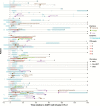Cytokine Release Syndrome Grade as a Predictive Marker for Infections in Patients With Relapsed or Refractory B-Cell Acute Lymphoblastic Leukemia Treated With Chimeric Antigen Receptor T Cells
- PMID: 29481659
- PMCID: PMC6070095
- DOI: 10.1093/cid/ciy152
Cytokine Release Syndrome Grade as a Predictive Marker for Infections in Patients With Relapsed or Refractory B-Cell Acute Lymphoblastic Leukemia Treated With Chimeric Antigen Receptor T Cells
Abstract
Background: Chimeric antigen receptor (CAR)-modified T cells that target the CD19 antigen present a novel promising therapy for the treatment of relapsed B-cell acute lymphoblastic leukemia (B-ALL). Although cytokine release syndrome (CRS) and neurotoxicity have emerged as predominant noninfectious complications of CD19 CAR T-cell therapy, infections associated with this treatment modality have not been well documented.
Methods: We analyzed infectious complications that followed CD19 CAR T-cell therapy in 53 adult patients with relapsed B-ALL enrolled in a phase I clinical trial at Memorial Sloan Kettering Cancer Center (NCT01044069).
Results: Overall, 22 patients (42%) experienced 26 infections (17 bacterial, 4 fungal, and 5 viral) within the first 30 days of CAR T-cell infusion. In 10 of 32 (31%) patients in whom complete remission was achieved, 15 infections developed between days 31 and 180; the majority of these late infections were due to respiratory viruses. In general, bacterial, fungal, and viral infections were detected at a median of 18, 23, and 48 days, respectively, after CAR T-cell infusion. CRS grade 3 or higher was independently associated with increased risk of subsequent infection (adjusted hazard ratio [HR], 2.67; P = .05) and in particular with bloodstream infection (adjusted HR, 19.97; P < .001). Three of 53 patients (6%) died of an infection-related cause.
Conclusions: Infections in adult patients with relapsed B-ALL are common after CD19 CAR T-cell therapy. Understanding the infectious complications that are temporally coincident with CD19 CAR T-cell therapy is critical for developing effective prophylactic and other supportive care measures to improve clinical outcomes.
Clinical trials registration: NCT01044069.
Figures


References
-
- Fielding AK, Richards SM, Chopra R, et al. ; Medical Research Council of the United Kingdom Adult ALL Working Party; Eastern Cooperative Oncology Group Outcome of 609 adults after relapse of acute lymphoblastic leukemia (ALL); an MRC UKALL12/ECOG 2993 study. Blood 2007; 109:944–50. - PubMed
Publication types
MeSH terms
Substances
Associated data
Grants and funding
LinkOut - more resources
Full Text Sources
Other Literature Sources
Medical

